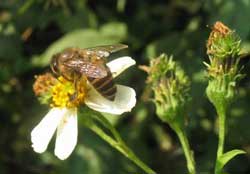To reduce the risk of infection from animal bites, it is essential to treat the wound as soon as possible. If more than 6 hours have passed since the bite, the risk of infection is significantly high, especially in the elderly and immunocompromised individuals.
Handling Animal Bites
 |
|
Bee venom can cause shock |
It is crucial to examine and assess the bite carefully for depth, tendons, vessels, tissue, and foreign bodies. If necessary, conduct tests and X-rays. The wound should be irrigated, preferably with pressurized clean water, multiple times to remove dirt and reduce bacteria and dead tissue.
To minimize the risk of infection, the wound must be treated as soon as possible. Never stitch the wound immediately; instead, clean and dress it according to its function, and try to keep the affected limb elevated at all times. Using antiseptic solutions like chlorhexidine gluconate, povidone-iodine, or 70% alcohol is essential. High-risk wounds must receive high-dose antibiotics for 3 to 5 days. The best antibiotic is amoxicillin-clavulanate (Augmentin) due to its broad spectrum of action. If allergic to penicillin, use cephalosporins like cefuroxime or doxycycline.
Bites from humans are even more dangerous as they can transmit viruses such as hepatitis B, C, HIV, and herpes simplex. In such cases, hepatitis B vaccination and immune globulin should be administered. If there is a risk of HIV exposure, appropriate antiretroviral medications should be started promptly. Consideration should also be given to tetanus vaccination for all bite cases.
Bites from dogs and cats can lead to fatal rabies, including scratches or saliva exposure to mucous membranes. The most important thing is to monitor the condition of the biting animal. If captured, including wild animals (foxes, weasels, rodents, bats, etc.), they should be killed, and the animal’s head should be preserved in cold storage and sent for testing. If the test is negative, vaccination is not required. For domestic animals, if there are no signs of rabies, carefully monitor them for 15 days; if they remain normal, vaccination is unnecessary. If the biting animal cannot be monitored and there is an outbreak of rabies, the wound should be cleaned with soapy water, and there is no need to stitch; rabies immunoglobulin and rabies vaccine should be administered.
Snake Bites
The most dangerous snake species include cobras, Malayan pit vipers, green pit vipers, and certain sea snakes. If bitten by a venomous snake, symptoms may include anxiety, dizziness, coagulopathy, hemolysis, bleeding, vomiting, diarrhea, electrolyte imbalances, acute renal failure, and shock.
In the event of a snake bite (even if the type of snake is unknown), call for help immediately. Rinse the area with plenty of clean water, apply pressure, and if necessary, enlarge the wound. Clean the area (using the aforementioned antiseptics), and if activated charcoal is available, apply it to the bite and bandage it. Transport the person to the hospital via ambulance or stretcher. Do not allow the patient to walk, run, or ride a bicycle or motorbike, as this may lead to circulatory collapse and shock.
Specific treatments for snake bites include antivenom, tetanus antitoxin, medications for coagulopathy, renal support, respiratory assistance, anti-edema medications, and pain relief. Before administering antivenom, a test must be conducted. Absolutely do not consume alcohol.
Insect Stings
The venom from various arthropods such as centipedes, spiders, and scorpions may contain neurotoxins or enzymes that can cause swelling, platelet aggregation, or thrombosis. These effects can diminish or lead to necrosis or ulceration. Insect venom can cause systemic symptoms such as fever, chills, vomiting, rashes, itching, jaundice, muscle spasms, localized stiffness, and infections.
When stung, it is essential to clean the wound, apply ice, and for some, apply lime for bee or ant stings. Pain relief can be achieved with medications like aspirin, paracetamol, or piroxicam, and soothing antihistamines such as promethazine, chlorpheniramine, or diphenhydramine may be administered. In some cases, corticosteroids or dapsone may be necessary to improve skin lesions. Applying a nitroglycerin patch to the sting site can help reduce vasoconstriction and prevent ulceration.
When stung by bees or fire ants, swelling and pain may escalate to the point of anaphylactic shock. Just 50 bee or fire ant stings can cause symptoms like edema, fatigue, vomiting, tinnitus, disseminated intravascular coagulation, rhabdomyolysis, and acute tubular necrosis. Immediate emergency care in a hospital is required. If stung by a few, avoid squeezing the sting site, gently remove the stinger, apply ice, and ideally use calamine lotion, corticosteroid creams like cortibion, hydrocortisone, betamethasone, or dexamethasone, and antihistamines to alleviate symptoms.
PharmD Pham Thiep, Health & Life


















































